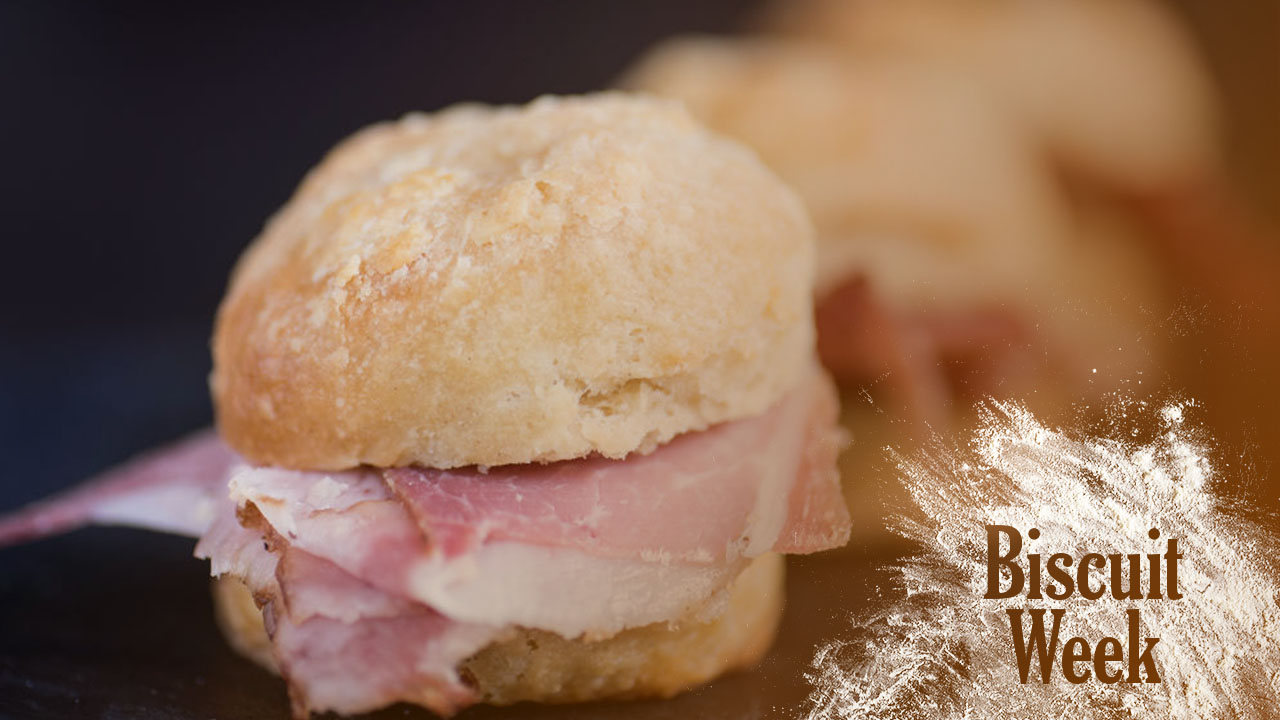Ham Biscuits Are A Casual Southern Tradition With Deep Roots
We may receive a commission on purchases made from links.
Welcome to Biscuit Week, a special time set aside to cherish the most buttery and beloved of all quick breads.
When The Takeout decided to dedicate an entire week to biscuits I immediately knew I wanted to write about ham biscuits, a fairly ubiquitous Southern treat that's at home on the family table as much as it is on the bleachers of a baseball diamond, at a post-service church buffet, or purchased from a gas station hot bar.
The thing is, ham biscuits aren't like red beans and rice, collards and pot liquor, or really any of the other Southern dishes that have penetrated beyond the borders of the American South. If you haven't spent time in the South, there's a chance you might not be familiar with this particular dish.
On a base level ham biscuits are exactly what they sound like: a biscuit filled with ham. They're greater than the sum of their parts, though, and like so many Southern foods it carries a historical legacy. Food writer and historian Toni Tipton-Martin writes in her recent book Jubilee: Recipes From Two Centuries Of African American Cooking that ham biscuits are descended from a time when enslaved Africans would eat biscuits filled with sliced salt pork. Recipes from contemporary cookbooks, including from authors such as Southern food empress Edna Lewis, suggest that after emancipation the filling of salt pork gave way to sliced ham or deviled ham, the latter being ham that's finely chopped and mixed with a binder (like mayonnaise or cream cheese), mustard, hot sauce (or fresh chopped chiles or dried chile powder), and a bevy of other ingredients that vary from one family recipe to the next.
In The Taste of Country Cooking, Lewis writes that the ham biscuits of Freetown, Virginia—a town settled by freed former slaves, which included her grandfather—were the sort of thing served casually "at ball games and suppers, and always at Sunday Revival." Those sandwiches were served fresh and "flannel-soft, a thin slice of ham inserted in each," but were also sometimes made with chipped ham, the bits and remnants left in a pan or on the bone after a large ham had been sliced. That chipped ham would be finely diced and added directly into the biscuits prior to their being baked, no sandwiching necessary.
What you're most likely to find now is a soft biscuit, split in two, that's filled with sliced ham and typically smeared with a piquant condiment such as mustard, either hot or sweet. Food writer and historian Dr. Jessica B. Harris notes in The Welcome Table: African-American Heritage Cooking that ham biscuits can come in a variety of sizes, sometimes large, sometimes the size of a silver dollar, and that the ham could either be quickly cut into chunks or sliced thinly and neatly.
There also doesn't seem to be a consensus about how ham biscuits should be dressed. Southern Living suggests using sweet toppings like jam and honey and also tantalizingly floats the idea of pimento cheese. Harris recommends freshly ground horseradish. Personally, I'd split the difference between sweet and savory and go with a healthy dose of pepper jelly.
What's possibly the most important component of the sandwich, though (other than the biscuit), is what type of ham is put in the middle. While not every person in the South eats pig, and pork products come in many different forms, the undisputed king of cured meats has to be country ham, a Southern heritage food that is increasingly endangered.
Country ham is to the Southern United States what prosciutto di Parma is to Italy or jamón Ibérico is to Spain: a preserved ham made using techniques passed down across multiple generations, but which involve rubbing the pork with salt (and other dry ingredients) and leaving it to hang while it cures, ferments, and reaches varying states of intensely flavored magic. The problem is that country ham is time intensive and expensive to make, and these days there are fewer and fewer smokehouses still producing this wonderfully unique cured meat.
Sam Edwards III, a third-generation master meat curer whose grandfather founded the venerable ham institution Edwards Virginia Smokehouse, is one of the people preserving the tradition. He says that the consistency of country ham depends on how long it's been hung for, and the method used to produce it. While this is a bit of a simplification, the longer the ham hangs for, the more concentrated the flavor and the more cured the appearance. Edwards' "Surryano" ham (a portmanteau of Surry, Virginia, where his business is located, and Serrano, Spain, which produces the world-famous Serrano ham) is much more akin to charcuterie than fresh ham. The country ham you're likely to find in a biscuit will be pink and gently marbled with fat, reminiscent of a typical supermarket ham but of infinitely better quality.
The reality is that with ham biscuits you sort of can't go wrong. Nothing can beat a freshly baked biscuit filled with warm sliced ham, but Dr. Jessica B. Harris notes that there's something wholeheartedly Southern about about making yourself a treat using leftover biscuits and cold ham. And even if you're not able to acquire country ham to make them at home, or are just buying a biscuit sandwich on the go from a fast food chain, remember that a dish as humble as a sandwich made from quick bread and sliced meat can have deep roots—and don't forget the mustard.
